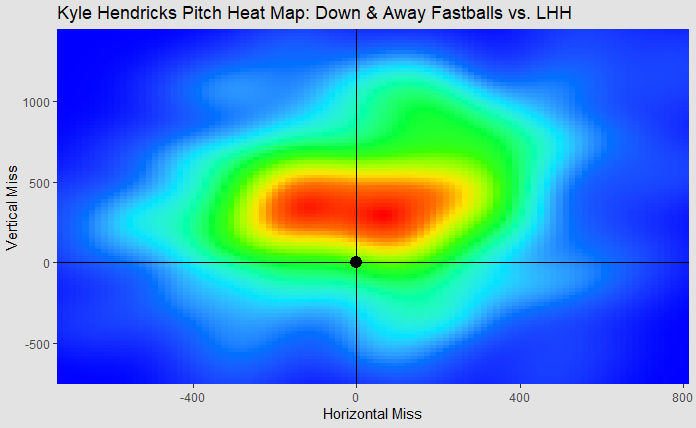Intended zone primer: What is it and how does it impact the Cubs?

Command has been a topic of observation. Either a pitcher had “it” in an outing, or he didn’t.
But the conversation in baseball has changed drastically over the last decade. Observation without data to back it up no longer drives the majority of decisions in front offices. The same could be said about information that makes its way into analysis. The modern fan wants perspective that is backed up by facts. Even if that fact runs counter to a commonly held belief.
With the help of Inside Edge, we’re doing our best to bring more perspective to the topic of command. And we’re doing that by incorporating “intended zone” data into broadcasts and conversation.
What is intended zone information?
Intended zone is the difference between where a pitcher intended to throw a pitch and where the pitch actually landed.
If a pitcher is within two baseballs, or about six inches, of his intended zone, we would consider that an “on target” pitch. If the actual location of the pitch is greater than two baseballs away from a pitcher’s intended zone, we would consider that a “miss.”
For every pitch thrown last year, Inside Edge has former players and coaches logging where they believe the pitcher intended a given pitch to land (Skeptical? Read the limitations section below). That information is then checked against the actual pitch location data provided to all major league teams.
After calculations of distance, we’re able to sort every pitcher in baseball based on how often they throw an on-target pitch. We can even look at individual pitch types, specific locations, and group command based on velocity.
Here’s a visual to help out:
Is the intended zone just the catcher’s target?
No. Often, this is used to inform where the intended zone for a given pitch could have been, but there are more factors at play.
The most common example is a high fastball. For the majority of high fastballs in baseball, a catcher isn’t often standing up out of a crouch to show the pitcher his glove at the top of the zone. The glove may linger around the middle of the plate or no target may be given at all and the pitcher may be looking to throw the ball at his catcher’s mask.
In this instance, the intended zone wouldn’t be the catcher’s glove, or the middle of the plate.
What is the league average “on target” rate?
Among all starting pitchers in MLB last year, the average on-target percentage was 58%.
58% of the time when a starting pitcher threw any pitch, he either hit or was within two baseballs of his intended zone.
But it’s important to consider velocity when talking about command. Please see the limitations question below for more detail.
Does the leaderboard pass the sniff test?
Here is a look at how four Cubs starting pitchers fared last season, out of 138 qualified starting pitchers in MLB. Note: the ranking does not take into account velocity, so we’re going to see some skew towards softer tossers being better at commanding the ball.
As Alec Mills told me this spring, “Guys that [have low velocity] have to be able to command to have success in the game.”
If you don’t throw hard and you’re not able to command the baseball, there’s a strong chance you’re not an MLB pitcher. More to come on adjustments we will make to counteract for this effect.
What are the limitations of intended zone data?
This information isn’t perfect.
The problem is that it will never be perfect. That is because to truly get the real intended location, you would need every pitcher in baseball to chart their intent on every single pitch they threw after their starts. And even then, you’d probably end up with some error.
But that doesn’t prevent organizations all across baseball — including the Cubs — from using this information to gain insights about command. And it won’t prevent us at Marquee from doing the same.
The main limitation is that looking at intended zone information without the context of a pitcher’s velocity can be deceptive. For example, if you plot pitcher’s velocity with their “on-target” percentage, you’ll see that among major league starting pitchers in 2021, as velocity increases, the ability to keep a given pitch on target decreases.
In fact, plotting the two shows us that for every 2 mph that a pitcher increases their fastball velocity, we’d expect their ability to stay within two baseballs of their intended target when throwing a fastball to decrease by about 10%.
What’s next?
Our data is purely for informational purposes. We want to create discussion with this information.
In major league organizations, the approach to this data changes. What’s important to a pitching coach trying to help a pitcher’s command improve is not necessarily on-target percentage, but rather in which direction the pitcher misses his target by and by how much.
The same intended zone data is used in that instance, but instead of producing a simple percentage based on our two-baseball standard for a missed target, a plot is created that shows in what direction a pitcher tends to miss.
In the example below, the dot in the center of the plot is the intended zone (down and away fastballs). The red blob above that dot shows where the resulting location of the pitch actually landed most often given these parameters.
You’d interpret the plot below by saying, “When Kyle Hendricks tries to throw a down-and-away fastball to a left-handed hitter, his most frequent miss is slightly above his intended zone.”
Determining how much Hendricks misses by relative to league average helps contextualize whether this average miss distance is good or needs improvement. From there, it’s the job of player development to figure out how to improve a pitcher’s command.





